|
Our first major stop was in Santa Fe, New Mexico, where we stayed with my old friend Peggy Creelman, who has an acupuncture clinic. Peggy specializes in treating immune system diseases with a combination of
acupuncture, reflexology, and Chinese herbal medicine. It was really great to see Peggy again and meet her husband Marcus. My son James was happy to reunite with Peggy’s super-cool daughter,
Noya Gilmore.
Sybil had never been to Santa Fe before, so we spent a lot of time seeing the nearby sights. Santa Fe (population approximately 60,000) retains that “small town” ambiance, despite its very real
sophistication. Once you learn to navigate the maze of old streets you discover it is really easy to get around in Santa Fe. We were able to walk downtown from Peggy’s house, but public parking
is available only a block off the main plaza, and many of the city’s prime attractions are within easy walking distance. The weather was glorious, with sunshine and the cool mountain air Santa Fe is
famous for.
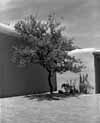 We went to a number of museums, including the new Georgia O’Keefe
Museum. I’m not sure they have O’Keefe’s best work at the museum, but the exhibit was interesting nonetheless, and I did note a number of items on
loan from individuals or other collections. I saw more of Stieglitz’s photos (I saw some before at MOMA and the Metropolitan when I was in NYC) and
was again struck by how dark all his prints are. I thought some of the reproductions were bad in the book I have (Alfred Steiglitz, Photographs & Writings), but they turned out to be quite accurate. We went to a number of museums, including the new Georgia O’Keefe
Museum. I’m not sure they have O’Keefe’s best work at the museum, but the exhibit was interesting nonetheless, and I did note a number of items on
loan from individuals or other collections. I saw more of Stieglitz’s photos (I saw some before at MOMA and the Metropolitan when I was in NYC) and
was again struck by how dark all his prints are. I thought some of the reproductions were bad in the book I have (Alfred Steiglitz, Photographs & Writings), but they turned out to be quite accurate.
I began taking a few photographs at this point, my first of the trip. I had taken my Mamiya 7 with the 80mm and 43mm lenses. The idea behind getting this camera in the first place was that
it can be used hand-held when necessary. Each lens has its own leaf shutter which flash-synchs all the way up to 1/500th of a second, and the camera is very light. It is also very tough, as I
discovered in Mexico in 1997, climbing Pena Nevado--it bounced out of a backpack and landed in the rocks, putting a dent in the door, but has continued to function perfectly, no light
-leaks, no blips. I decided to shoot Delta 3200, rated at 800, in Santa Fe, because I didn’t want to carry my tripod in the street. The photographs of the tree in the courtyard of the
O’Keefe Museum, and of the San Miguel Mission were taken on this film.
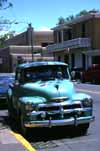 One day when we were walking downtown we encountered an old turquoise
-colored Chevy pickup with a hood ornament just like the one I had on my ‘53 Chevy Belaire. I have only seen five or six like it my life. As Sybil
finished taking photographs, the owner walked up and we started a conversation. He said Chevy had the hood ornaments left over from 1953,
when they only used them on the deluxe edition of the Belaire, so they put them on 200 deluxe edition 1954 pickup trucks. He said there are only about 50 of them still running. One day when we were walking downtown we encountered an old turquoise
-colored Chevy pickup with a hood ornament just like the one I had on my ‘53 Chevy Belaire. I have only seen five or six like it my life. As Sybil
finished taking photographs, the owner walked up and we started a conversation. He said Chevy had the hood ornaments left over from 1953,
when they only used them on the deluxe edition of the Belaire, so they put them on 200 deluxe edition 1954 pickup trucks. He said there are only about 50 of them still running.
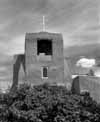 Sybil is much more of a museum-goer than I am, so I flaked out pretty
quickly, but did manage to see parts of the Museum of Fine Arts, the Museum of International Folk Art, and the Museum of Indian Arts and
Culture. The latter was my favorite. While Sybil toured the downtown museums, I wandered off and photographed the oldest church in North
America, the San Miguel Mission, dated 1610. I also found some interesting art and photographic galleries as I walked down behind the mission. Sybil is much more of a museum-goer than I am, so I flaked out pretty
quickly, but did manage to see parts of the Museum of Fine Arts, the Museum of International Folk Art, and the Museum of Indian Arts and
Culture. The latter was my favorite. While Sybil toured the downtown museums, I wandered off and photographed the oldest church in North
America, the San Miguel Mission, dated 1610. I also found some interesting art and photographic galleries as I walked down behind the mission.
 Santa Fe is an art lover’s paradise with Indian and Southwestern Art
taking center stage. After Ed departed, I continued on through the exhibits. When it comes to museum-going and shopping, it’s best if
Ed and I part company. I went on to the Institute of American Indian Arts Museum which shows modern works by Indian artists
from all over the country. The main businesses of Santa Fe are art and tourism, and there appear to be more first class art galleries there than most anywhere except maybe
Carmel, CA, or New York City. At the Museum of Indian Arts & Culture I discovered the work of Helen Hardin, a Native-American from Santa Clara Pueblo. She combined the
traditional Indian symbols and images with modern art in vivid color. Although she was the same age as I am, she died in 1984 from breast cancer. A tragic loss. I bought a book about her: Changing Woman: The Life and Art of Helen Hardin by Jay Scott. Santa Fe is an art lover’s paradise with Indian and Southwestern Art
taking center stage. After Ed departed, I continued on through the exhibits. When it comes to museum-going and shopping, it’s best if
Ed and I part company. I went on to the Institute of American Indian Arts Museum which shows modern works by Indian artists
from all over the country. The main businesses of Santa Fe are art and tourism, and there appear to be more first class art galleries there than most anywhere except maybe
Carmel, CA, or New York City. At the Museum of Indian Arts & Culture I discovered the work of Helen Hardin, a Native-American from Santa Clara Pueblo. She combined the
traditional Indian symbols and images with modern art in vivid color. Although she was the same age as I am, she died in 1984 from breast cancer. A tragic loss. I bought a book about her: Changing Woman: The Life and Art of Helen Hardin by Jay Scott.
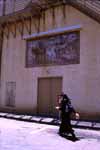 I read somewhere that Santa Fe is a world-renowned shopping
destination. There certainly are a lot of high end jewelry and boutique stores, plus some neat bookstores. It’s a dangerous place to be if you don’t have a good control on your pocketbook. I did learn something
about Navajo rugs thanks to a very nice and knowledgable salesman. Hopefully, he could see that I wasn’t about to spend several hundred
dollars on a rug I had no place for. James and I covered the stores pretty thoroughly (again we sent Ed off to photograph something).
Books are my weakness and I discovered a wonderful bookstore, called Alla, run by James Dunlap and Barbara Sommer. They specialize in Spanish language
and English books on art, history, archaeology and music. Mr. Dunlap and I chatted a bit on archaeology in the Amazon basin, a subject he seemed quite familiar with. I’ll be sure
to go back next time I’m in Santa Fe. For all my browsing, the only purchase I made (you can’t count the books!) was a pair of silver earrings from one of the Indian vendors
on the plaza. Local Indians come to the veranda of the Governors Palace to sell their wares, and this is about the only place in Santa Fe you can find a bargain. I read somewhere that Santa Fe is a world-renowned shopping
destination. There certainly are a lot of high end jewelry and boutique stores, plus some neat bookstores. It’s a dangerous place to be if you don’t have a good control on your pocketbook. I did learn something
about Navajo rugs thanks to a very nice and knowledgable salesman. Hopefully, he could see that I wasn’t about to spend several hundred
dollars on a rug I had no place for. James and I covered the stores pretty thoroughly (again we sent Ed off to photograph something).
Books are my weakness and I discovered a wonderful bookstore, called Alla, run by James Dunlap and Barbara Sommer. They specialize in Spanish language
and English books on art, history, archaeology and music. Mr. Dunlap and I chatted a bit on archaeology in the Amazon basin, a subject he seemed quite familiar with. I’ll be sure
to go back next time I’m in Santa Fe. For all my browsing, the only purchase I made (you can’t count the books!) was a pair of silver earrings from one of the Indian vendors
on the plaza. Local Indians come to the veranda of the Governors Palace to sell their wares, and this is about the only place in Santa Fe you can find a bargain.
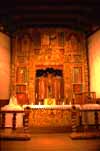 We stayed around Santa Fe for three days, taking a cruise out to Chimayo and Espaņola, driving up to the ski basin, and visiting some of the friends I
made when I lived in Santa Fe over 20 years ago. Paul Horgan’s Great River: The Rio Grande in North American History, which was
recommended to me by Mr. Dunlap at the bookstore, is a wonderful history of New Mexico and the Southwest. I wish I had read it before we visited Santa Fe because there is so much history here. Santa Fe is
actually the second capital of New Mexico. The Spaniards, under the first governor Don Juan de Oņate, established their first colony called
San Juan de los Caballeros in 1598 on the Rio Grande in the vicinity of Espaņola and San
Juan Pueblo. They displaced the Pueblo Indians who already lived there (literally asked them to leave their homes). This colony was a disastrous enterprise that ended in failure
and cost hundreds or thousands of Indian lives. The cruel Oņate was eventually recalled in disgrace and the colony was moved to Santa Fe in 1610. I never could find the actual
site of the original colony on a map, which seems strange given the significance of it. We stayed around Santa Fe for three days, taking a cruise out to Chimayo and Espaņola, driving up to the ski basin, and visiting some of the friends I
made when I lived in Santa Fe over 20 years ago. Paul Horgan’s Great River: The Rio Grande in North American History, which was
recommended to me by Mr. Dunlap at the bookstore, is a wonderful history of New Mexico and the Southwest. I wish I had read it before we visited Santa Fe because there is so much history here. Santa Fe is
actually the second capital of New Mexico. The Spaniards, under the first governor Don Juan de Oņate, established their first colony called
San Juan de los Caballeros in 1598 on the Rio Grande in the vicinity of Espaņola and San
Juan Pueblo. They displaced the Pueblo Indians who already lived there (literally asked them to leave their homes). This colony was a disastrous enterprise that ended in failure
and cost hundreds or thousands of Indian lives. The cruel Oņate was eventually recalled in disgrace and the colony was moved to Santa Fe in 1610. I never could find the actual
site of the original colony on a map, which seems strange given the significance of it.
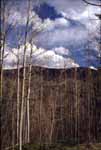 We visited the Santuario de Chimayo, a shrine built in 1816 when New
Mexico was still part of Mexico. A miracle supposedly occurred at the site and that’s why the shrine was built. I actually did read about this
but forgot what the exact nature of the miracle was. Chimayo is also famous for its weavers and several generations of weavers live in the
area. Up in the ski basin, there was still snow on the ground and the aspens had not yet budded out. That seemed eerie (this was May 18, 1999) because it was already summer in Texas. We visited the Santuario de Chimayo, a shrine built in 1816 when New
Mexico was still part of Mexico. A miracle supposedly occurred at the site and that’s why the shrine was built. I actually did read about this
but forgot what the exact nature of the miracle was. Chimayo is also famous for its weavers and several generations of weavers live in the
area. Up in the ski basin, there was still snow on the ground and the aspens had not yet budded out. That seemed eerie (this was May 18, 1999) because it was already summer in Texas.
 The first person I contacted, besides Peggy, was Steve Terrell, who used to work at the Stag Tobacconist with me in DeVargas Mall. Steve is
now music critic and crime reporter for the Santa Fe New Mexican. He has lived in Santa Fe most of his life and knows virtually everyone. Steve
is also a musician with two albums to his credit. Check out his web site, which has the best coverage of SXSW I have read, reviews of local
music, and true crime stories from the “city different.” Steve is one of the funniest people I have
ever met, with an incisive intelligence and a keen memory for detail. He told us his Daughter, Molly, is about to graduate from high school and he plans to take her up to Denver to see and
hear the Bob Dylan/Paul Simon concert. The first person I contacted, besides Peggy, was Steve Terrell, who used to work at the Stag Tobacconist with me in DeVargas Mall. Steve is
now music critic and crime reporter for the Santa Fe New Mexican. He has lived in Santa Fe most of his life and knows virtually everyone. Steve
is also a musician with two albums to his credit. Check out his web site, which has the best coverage of SXSW I have read, reviews of local
music, and true crime stories from the “city different.” Steve is one of the funniest people I have
ever met, with an incisive intelligence and a keen memory for detail. He told us his Daughter, Molly, is about to graduate from high school and he plans to take her up to Denver to see and
hear the Bob Dylan/Paul Simon concert.
 The other person we visited was Steve’s brother, Jack Clift. Jack is another amazing person--a renaissance man who does everything well.
He is a poet, musician, marshal artist, amateur archaeologist, and expert on Southwestern antiquities. It was fascinating to visit him at his small
house in Santa Fe, where every square inch of floor and wall is covered with musical instruments, books, art, and artifacts. Jack has produced
two CDs of music in the ten years since I last saw him--get details at his web site. He is a very
sophisticated musician. We met Jack’s friend, Tom Adler, who in addition to being a really nice guy (he bought our lunch) is apparently a local musical legend. Read about him on his web site. I wish we had been able to stay in Santa Fe a few more days so we could spend some more
time with these two guys. If I’d had my guitar there I would have liked to jam with Jack and
Tom, though I’m certain I’d have been hopelessly outclassed. Maybe I could have picked up some new licks though. The other person we visited was Steve’s brother, Jack Clift. Jack is another amazing person--a renaissance man who does everything well.
He is a poet, musician, marshal artist, amateur archaeologist, and expert on Southwestern antiquities. It was fascinating to visit him at his small
house in Santa Fe, where every square inch of floor and wall is covered with musical instruments, books, art, and artifacts. Jack has produced
two CDs of music in the ten years since I last saw him--get details at his web site. He is a very
sophisticated musician. We met Jack’s friend, Tom Adler, who in addition to being a really nice guy (he bought our lunch) is apparently a local musical legend. Read about him on his web site. I wish we had been able to stay in Santa Fe a few more days so we could spend some more
time with these two guys. If I’d had my guitar there I would have liked to jam with Jack and
Tom, though I’m certain I’d have been hopelessly outclassed. Maybe I could have picked up some new licks though.
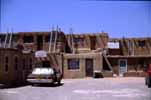 We drove South to Albuquerque (pop. 412,000) where we put
James on a plane back to Austin, then Sybil and I proceded West to Acoma Pueblo. When we got to the visitor center we found the highway blocked off, a huge trailer being unloaded in the parking lot,
chairs and a stage being set up half on the highway, and the visitor center in the midst of remodelling. We were directed to a temporary
trailer to get our tickets. There we learned that Hillary Clinton was expected to arrive the next day to give the tribe a bunch of money. The Acoma Puebloans were a bit sceptical of the whole
deal after the Secret Service tried to order everyone off the mesa. The SS got a quick lesson in tribal autonomous government. I’m sure that, despite any paranoid fantasies that may have
arisen, the first lady was never in any danger--not from the Puebloans in any case. We drove South to Albuquerque (pop. 412,000) where we put
James on a plane back to Austin, then Sybil and I proceded West to Acoma Pueblo. When we got to the visitor center we found the highway blocked off, a huge trailer being unloaded in the parking lot,
chairs and a stage being set up half on the highway, and the visitor center in the midst of remodelling. We were directed to a temporary
trailer to get our tickets. There we learned that Hillary Clinton was expected to arrive the next day to give the tribe a bunch of money. The Acoma Puebloans were a bit sceptical of the whole
deal after the Secret Service tried to order everyone off the mesa. The SS got a quick lesson in tribal autonomous government. I’m sure that, despite any paranoid fantasies that may have
arisen, the first lady was never in any danger--not from the Puebloans in any case.
 We had to take a bus to the mesa-top, though we were allowed to walk down (Climb down is more accurate!) if we wished. There was a camera fee of
$10 per camera, in addition to the $10 admission fee, and no tripods allowed. Photographs taken in the pueblo cannot be used for commercial purposes, so
these are not for sale. We were not allowed to photograph inside the church or the cemetery, and if we wished to photograph people we were required to
obtain their permission (a common enough courtesy, one would think, though not practiced universally). Our tour guide was a young Indian who had just
graduated high school and spoke of plans to go to college. I believe his name was Thomas, but
I didn’t write it down so I’m not certain. He took us straight to the church, which was huge, at
least 60 feet tall, with thick adobe walls. A cave-like coolness persisted inside. He told us that the church was built by the forced labor of the Acoma men, under the supervision of the Spanish
friars. The pine vigas (roof beams) had to be carried for 30 miles on the shoulders of multiple Acoma men, who were not allowed to let them touch the ground during the We had to take a bus to the mesa-top, though we were allowed to walk down (Climb down is more accurate!) if we wished. There was a camera fee of
$10 per camera, in addition to the $10 admission fee, and no tripods allowed. Photographs taken in the pueblo cannot be used for commercial purposes, so
these are not for sale. We were not allowed to photograph inside the church or the cemetery, and if we wished to photograph people we were required to
obtain their permission (a common enough courtesy, one would think, though not practiced universally). Our tour guide was a young Indian who had just
graduated high school and spoke of plans to go to college. I believe his name was Thomas, but
I didn’t write it down so I’m not certain. He took us straight to the church, which was huge, at
least 60 feet tall, with thick adobe walls. A cave-like coolness persisted inside. He told us that the church was built by the forced labor of the Acoma men, under the supervision of the Spanish
friars. The pine vigas (roof beams) had to be carried for 30 miles on the shoulders of multiple Acoma men, who were not allowed to let them touch the ground during the 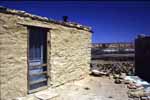 entire journey. I asked if the Acoma people were still Catholic, and he replied that
they practice their native religion in addition to Roman Catholicism. There was a photograph of the cemetery on the wall of the church, taken I suppose by a native photographer. The wall around the
cemetery is topped with adobe human-like heads representing spirits which are supposed to watch over the cemetery. There is
also a hole in one side of the wall to allow the souls of lost Indian children to enter. entire journey. I asked if the Acoma people were still Catholic, and he replied that
they practice their native religion in addition to Roman Catholicism. There was a photograph of the cemetery on the wall of the church, taken I suppose by a native photographer. The wall around the
cemetery is topped with adobe human-like heads representing spirits which are supposed to watch over the cemetery. There is
also a hole in one side of the wall to allow the souls of lost Indian children to enter.
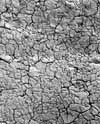 The tour proceeded very slowly, with stops along the way to look at various
families’ pottery and other crafts. The Acoma claim they have inhabited the mesa continuously since the 12th century CE. One of Coronado’s
subordinates described Acoma in 1540 as a citadel on the rock. The Spaniards climbed the mesa to visit but complained about the difficulty
of the ascent. If it was anything like the descent that Ed and I took, I understand. The path is very narrow and there are hand holds and toe
holds carved into the rock. Acoma apparently escaped the early depredations of the Conquistadors that the less protected pueblos along the Rio Grande suffered. Although the Pueblo Indians were at first open and friendly to the Spaniards,
the Spaniards abused and exploited the Indians in their quest for gold and riches. The Indians were forced to give the Spaniards food, clothing, often their very pueblos, and
many of their leaders were imprisoned or executed. Naturally, the Indians resisted but generally they were no match for the guns and horses of the Spaniards. The tour proceeded very slowly, with stops along the way to look at various
families’ pottery and other crafts. The Acoma claim they have inhabited the mesa continuously since the 12th century CE. One of Coronado’s
subordinates described Acoma in 1540 as a citadel on the rock. The Spaniards climbed the mesa to visit but complained about the difficulty
of the ascent. If it was anything like the descent that Ed and I took, I understand. The path is very narrow and there are hand holds and toe
holds carved into the rock. Acoma apparently escaped the early depredations of the Conquistadors that the less protected pueblos along the Rio Grande suffered. Although the Pueblo Indians were at first open and friendly to the Spaniards,
the Spaniards abused and exploited the Indians in their quest for gold and riches. The Indians were forced to give the Spaniards food, clothing, often their very pueblos, and
many of their leaders were imprisoned or executed. Naturally, the Indians resisted but generally they were no match for the guns and horses of the Spaniards.
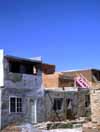 Most of the buildings didn’t look any different than most other adobes I have
seen, except they were plastered with mud instead of stuccoed. In the matriarchal society of the Acoma, the women own all the property and do all
the upkeep on the buildings. Property is inherited by the youngest daughter. Women are not allowed inside the kivas, which have become the exclusive
province of men (this didn’t use to be so, as we found when we visited Mesa Verde). I don’t know if the men build the kivas, but I suspect they do. Most
of the Acoma people we met were educated, articulate, and well-travelled. We met several who said they have been to Austin. Most of the buildings didn’t look any different than most other adobes I have
seen, except they were plastered with mud instead of stuccoed. In the matriarchal society of the Acoma, the women own all the property and do all
the upkeep on the buildings. Property is inherited by the youngest daughter. Women are not allowed inside the kivas, which have become the exclusive
province of men (this didn’t use to be so, as we found when we visited Mesa Verde). I don’t know if the men build the kivas, but I suspect they do. Most
of the Acoma people we met were educated, articulate, and well-travelled. We met several who said they have been to Austin.
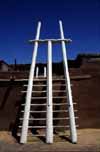 Bread is still baked daily in traditional mud brick ovens. There are no utilities
on top of the mesa--water is carried in, and kerosene lanterns and wood-burning stoves are used. Only about 200 people (30 families) still occupy
the traditional pueblo atop the mesa, so most of the buildings are unused. The Acoma make some pots using modern techniques, but their most expensive
are still completely hand made, and with great skill. We watched one woman painting designs freehand with a yucca fiber brush--she worked unhesitatingly.
Another man told us his pots have taken prizes all over the country. One old woman showed us her pots, and it was obvious that she could no longer see
well, as her pots were poorly painted. Her face was as wrinkled and cracked as the mud wall I photographed, and I longed to take her picture but dared not importune her. I was sorry no
one was buying her pots though. Looking into her face was like looking back in time. Bread is still baked daily in traditional mud brick ovens. There are no utilities
on top of the mesa--water is carried in, and kerosene lanterns and wood-burning stoves are used. Only about 200 people (30 families) still occupy
the traditional pueblo atop the mesa, so most of the buildings are unused. The Acoma make some pots using modern techniques, but their most expensive
are still completely hand made, and with great skill. We watched one woman painting designs freehand with a yucca fiber brush--she worked unhesitatingly.
Another man told us his pots have taken prizes all over the country. One old woman showed us her pots, and it was obvious that she could no longer see
well, as her pots were poorly painted. Her face was as wrinkled and cracked as the mud wall I photographed, and I longed to take her picture but dared not importune her. I was sorry no
one was buying her pots though. Looking into her face was like looking back in time.
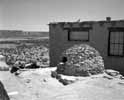 I had a hard time paying attention to the tour guide because I wanted to look at the beautiful pottery that various people had put
out on tables for sale. The tour went so quickly that I often was left behind. If we wanted to buy pots, we had to remember which table
it was so that we could come back after the tour (again with a guide). I had a hard time finding one of the pots that I thought I wanted.
Maybe the potter had already left. But I did find two beautiful pots that I bought. One is a traditional hand-made, painted pot. They also sell hand-painted greenware (poured in
molds) which is cheaper, but they tell you which is which. The traditional pots are made from clay that the potter may excavate him/herself and shapes using coils to build up the
pot. Traditional methods are handed down in families and there are family names that are famous for their pots. Some of these pots fetch thousands of dollars and are much
sought after by collectors. The pots are cheaper in Acoma because you don’t have to pay the high gallery markups and the money goes directly to the artist. I bought mine from
Emil Chino. The Chino family I had a hard time paying attention to the tour guide because I wanted to look at the beautiful pottery that various people had put
out on tables for sale. The tour went so quickly that I often was left behind. If we wanted to buy pots, we had to remember which table
it was so that we could come back after the tour (again with a guide). I had a hard time finding one of the pots that I thought I wanted.
Maybe the potter had already left. But I did find two beautiful pots that I bought. One is a traditional hand-made, painted pot. They also sell hand-painted greenware (poured in
molds) which is cheaper, but they tell you which is which. The traditional pots are made from clay that the potter may excavate him/herself and shapes using coils to build up the
pot. Traditional methods are handed down in families and there are family names that are famous for their pots. Some of these pots fetch thousands of dollars and are much
sought after by collectors. The pots are cheaper in Acoma because you don’t have to pay the high gallery markups and the money goes directly to the artist. I bought mine from
Emil Chino. The Chino family 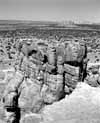 is one of the famous Acoma potter families but I don’t
know if he is one of that family or not. The different pueblos have different pottery styles and the traditional designs go back generations,
all the way to the Anasazi. The other pot was a non-traditional design with a red glaze, engraved thunderbirds and turquoise inlays by C.
Maurus Chino. He has won several awards for his pottery and has Bachelor of Fine Arts degree. These are my first two pots, but I plan on going back for more. is one of the famous Acoma potter families but I don’t
know if he is one of that family or not. The different pueblos have different pottery styles and the traditional designs go back generations,
all the way to the Anasazi. The other pot was a non-traditional design with a red glaze, engraved thunderbirds and turquoise inlays by C.
Maurus Chino. He has won several awards for his pottery and has Bachelor of Fine Arts degree. These are my first two pots, but I plan on going back for more.
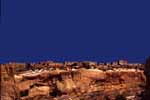 Acoma was the scene of a bloody attempt to drive out the
Spaniards and a bloodier reprisal. In the winter of 1598, a party of Spanish soldiers stopped at Acoma to get provisions and shelter. The Spaniards raised no crops of their own nor did they
make any of their clothes or build their own buildings. It was their wont to take these as they needed them from the Indians
with no thought of payment. Having had enough of this and thinking that the guns made only smoke and noise and that they could easily overcome the soldiers, the Indians lured the Acoma was the scene of a bloody attempt to drive out the
Spaniards and a bloodier reprisal. In the winter of 1598, a party of Spanish soldiers stopped at Acoma to get provisions and shelter. The Spaniards raised no crops of their own nor did they
make any of their clothes or build their own buildings. It was their wont to take these as they needed them from the Indians
with no thought of payment. Having had enough of this and thinking that the guns made only smoke and noise and that they could easily overcome the soldiers, the Indians lured the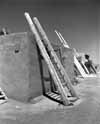 soldiers into the city and when they were unaware, attacked them. Eleven soldiers
and two servants were killed. To punish Acoma, the Governor sent out an army of 70 well-armed soldiers as well as artillary. Almost a
thousand Indians were killed and the city was burned. Of the Indians taken prisoner, males over 25 had one foot cut off and the women and younger males were forced to be personal slaves for 20 years. soldiers into the city and when they were unaware, attacked them. Eleven soldiers
and two servants were killed. To punish Acoma, the Governor sent out an army of 70 well-armed soldiers as well as artillary. Almost a
thousand Indians were killed and the city was burned. Of the Indians taken prisoner, males over 25 had one foot cut off and the women and younger males were forced to be personal slaves for 20 years.
|